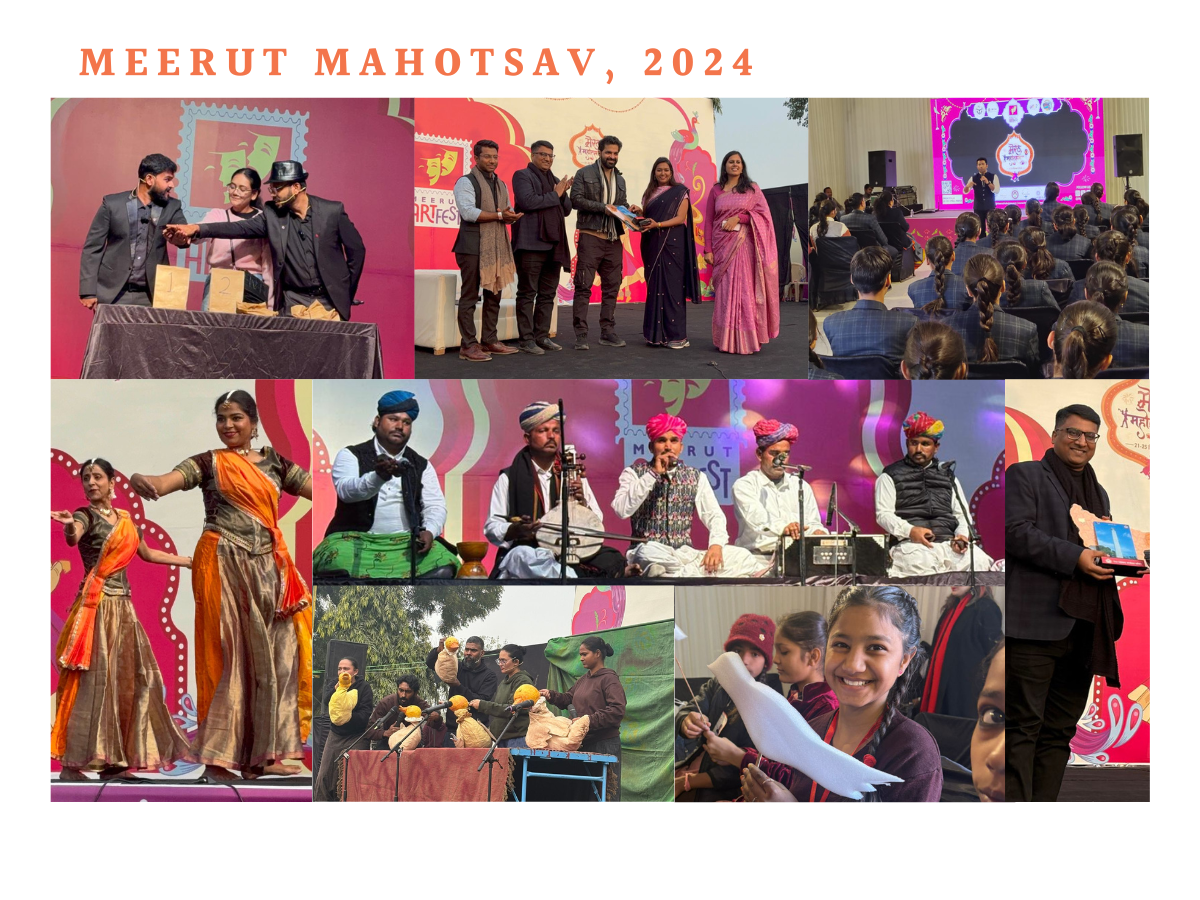
Art and it’s role in the modern world
There’s a story we all share, one that stretches back through generations – a story that is told not just through words but through the strokes of a paintbrush, the rhythm of a dance, and the melody of a song. Art has always been the quiet companion to human life, reflecting our joys, our struggles, and the dreams we dare to chase. We remember attending the Meerut Mahotsav, a celebration where every corner echoed with passion, tradition, and modernity. The laughter of children learning to make puppets, the graceful movements of dancers telling ancient stories, and the vibrant paintings that seemed to come alive – they all whispered something deeper.
This wasn’t just a festival of performances or a showcase of artistic talent; it was a carnival, a gathering of souls, united by the belief that art can heal, unite, and transform. It was a reminder that, in our ever-changing world, the heart of art beats stronger than ever. The energy, the stories, and the emotions shared at this Mahotsav weren’t just expressions of skill—they were reflections of who we are and the journey we’ve all been on.
1. Art as a Medium of Expression and Identity
Art has always been a powerful tool for self-expression, allowing individuals to convey emotions, ideas, and identities that might otherwise remain unheard. In today’s world, this role has expanded exponentially through digital platforms. Whether it’s an Instagram artist sharing vibrant illustrations or a filmmaker creating thought-provoking documentaries, art gives people the ability to share their unique stories with a global audience.
Moreover, art helps communities preserve and celebrate their cultural heritage. Traditional art forms like Kathak, Rajasthani folk music, and puppetry not only keep ancient traditions alive but also adapt to contemporary contexts, making them relevant and engaging for younger generations.
2. Art as a Catalyst for Social Change
Art possesses the remarkable ability to challenge societal norms and spark dialogue around critical issues. Street art, for instance, has become a global phenomenon, shedding light on topics like climate change, inequality, and mental health. Performances, exhibitions, and public installations often serve as platforms to question the status quo and advocate for a more equitable and inclusive world.
In India, initiatives like Ishara Theatre Trust’s performances and workshops illustrate how art can address themes of self-worth, resilience, and acceptance. These narratives inspire audiences to rethink prejudices and embrace diversity.
3. Art in the Digital Landscape
The advent of technology has transformed how art is created, consumed, and shared. Digital art, augmented reality (AR) installations, and virtual galleries have revolutionized the way we engage with creative works. Platforms like YouTube, Spotify, and social media have democratized access, giving artists from all walks of life the ability to reach audiences across the globe.
Additionally, the rise of NFTs (non-fungible tokens) has created new opportunities for artists to monetize their work, challenging traditional art market dynamics and empowering creators in unprecedented ways.
4. Art in Education and Personal Growth
Art education fosters creativity, critical thinking, and emotional intelligence—skills that are increasingly valued in a world driven by innovation. Workshops like those seen at Meerut Mahotsav, from puppet-making sessions to storytelling exercises, highlight how art can ignite curiosity and nurture talent in individuals of all ages.
Beyond formal education, engaging with art—be it through attending performances, visiting museums, or participating in community projects—enriches our lives and enhances our understanding of the world around us.
5. Art as a Unifying Force
In a world often divided by politics, religion, and ideologies, art acts as a bridge that connects people. Music, dance, literature, and visual art transcend linguistic and cultural barriers, reminding us of our shared humanity. Events like Meerut Mahotsav epitomize this, bringing together diverse voices and showcasing the beauty of collaboration.
6. Art as a Mirror to Society
Art reflects the realities of the time in which it is created, offering a lens through which future generations can understand our struggles, triumphs, and values. The works of contemporary artists—whether subtle portraits of everyday life or bold critiques of societal structures—serve as historical records that encapsulate the spirit of our age.
Conclusion: Art’s Timeless Relevance
In the modern world, art is more than an aesthetic pursuit; it is a vital force that shapes societies, empowers individuals, and bridges divides. From the digital revolution to grassroots movements, art’s relevance and impact continue to evolve, reminding us of its timeless ability to inspire, transform, and unite.
At Varnan, we celebrate the transformative power of art and storytelling. Whether it’s through curating cultural events, crafting compelling narratives, or fostering creativity in local communities, we strive to honor the enduring legacy of art in all its forms. Because in the end, art is not just what we create; it’s what connects us all.


